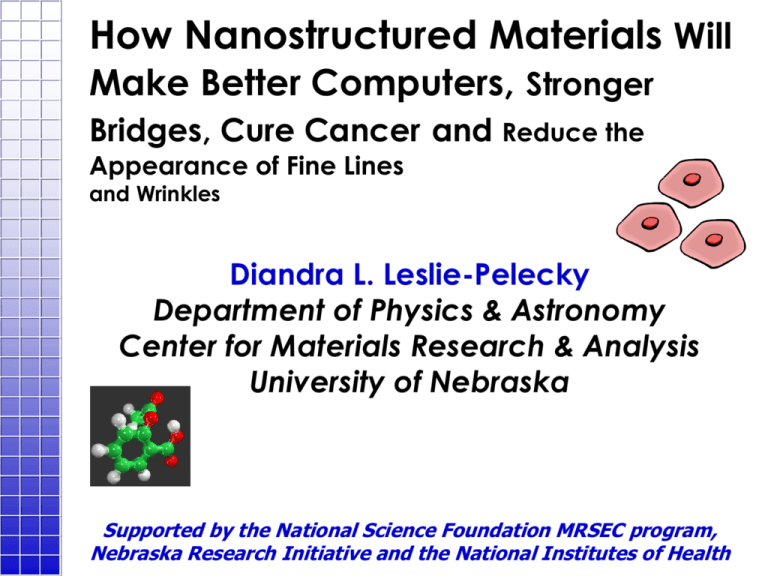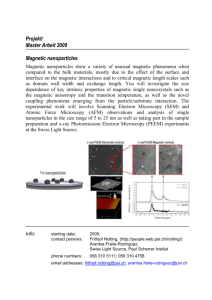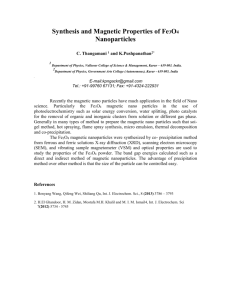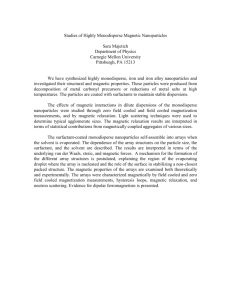How Nanostructured Materials Will Make Better Computers
advertisement

How Nanostructured Materials Will Make Better Computers, Stronger Bridges, Cure Cancer and Reduce the Appearance of Fine Lines and Wrinkles Diandra L. Leslie-Pelecky Department of Physics & Astronomy Center for Materials Research & Analysis University of Nebraska Supported by the National Science Foundation MRSEC program, Nebraska Research Initiative and the National Institutes of Health Acknowledgements UNL Marco Morales Kishore Sreenivasan David Schmitter Ray Lemoine Steve Wignall Hai Nguyen Shannon Fritz Michelle Strand Collaborators • V. Labhasetwar (UNMC) • M. Boska • R. Kraus, Jr. • M. Espy (UNMC) (Los Alamos) (Los Alamos) T. Jain S. Sahoo Outline • Nanotechnology: What and Why? • What is nanomedicine? • Overview of magnetic nanoparticle applications in medicine • Our work Targeted drug delivery Stoke treatment/diagnosis Making a better nanoparticle for magnetic targeting • Conclusions Nanotechnology Why? Why Now? What is ‘Nano’? Nano = one billionth Nanometer = one billionth of a meter •About ten times the size of an individual atom. •There are as many nanometers in an inch as there are inches in 400 miles. Feynman – 1959 – Caltech “…let us say that there are some 24 million volumes of interest in the world. ...I have assumed that each of my 24 million books is as big as an Encyclopedia volume, and have calculated, then, how many bits of information there are (1015). For each bit I allow 100 atoms. And it turns out that all of the information … can be written in this form in a cube of material one two-hundredth of an inch wide -- which is the barest piece of dust that can be made out by the human eye. So there is plenty of room at the bottom! Why Nano? Nanoscale materials can have properties that are unrealizable in bulk materials Making a material nanoscale can change its • Melting temperature • Magnetization • Ability to hold charge • Structure • Chemical reactivity • … among other things Clinton – Caltech - 2000 Grand Challenges • Containing the entire contents of the Library of Congress in a device the size of a sugar cube; • Making materials and products from the bottom-up, that is, by building them up from atoms and molecules. (less material and less pollution); • Developing materials 10 times stronger than steel, but a fraction of the weight; • Improving the computer speed and efficiency of minuscule transistors and memory chips by factors of millions; • Detecting cancerous tumors that are only a few cells in size using nanoengineered contrast agents; • Removing the finest contaminants from water and air => cleaner environment and potable water at an affordable cost Nanotechnology Dollars Agency 2004 Estimate 2003 Actual 2005 Proposed % Change, 2004 to 2005 NSF 221 254 305 20% DOD 322 315 276 -12% DOE 134 203 211 4% HHS (NIH) 78 80 89 11% DOC (NIST) 64 63 53 -16% NASA 36 37 35 -5% USDA 0 1 5 400% EPA 5 5 5 0% DHS (TSA) 1 1 1 0% DOJ 1 2 2 0% 862 961 982 2% TOTAL ($M) U.S. nanotechnology R&D will reach nearly $3.3 billion in 2007 Commercial market ~10 X to 100 X as big as the R&D market Magneti Paramagnetism H H=0 H M H H=0 Ferromagnetism H H=0 H M H H Hysteresis Loop M Remanent Magnetization, Mr Saturation Magnetization, Ms Coercivity, Hc H Magnetic Periodic Table 1 H 2 He 3 Li 4 Be 11 Na 12 Mg 19 K 20 Ca Red = Ferromagnetic Blue = Antiferromagnetic 21 Sc 22 Ti 23 V 24 Cr 25 Mn 312 K 96 K 26 Fe 27 Co 1043 K 1390 K 28 Ni 5 B 6 C 7 N 8 O 9 F 10 Ne 13 Al 14 Si 15 P 16 S 17 Cl 18 Ar 29 Cu 30 Zn 31 Ga 32 Ge 33 As 34 Se 35 Br 36 Kr 629 K 37 Rb 38 Sr 39 Y 40 Zr 41 Nb 42 Mo 43 Tc 44 Ru 45 Rh 46 Pd 47 Ag 48 Cd 49 In 50 Sn 51 Sb 52 Te 53 I 54 Xe 55 Cs 56 Ba 57 La 72 Hf 73 Ta 74 W 75 Re 76 Os 77 Ir 78 Pt 79 Am 80 Hg 81 Tl 82 Ph 83 Bh 84 Po 85 At 86 Rm 87 Fr 88 Ra 89 Ac 58 60 Ce Nd 13 K 59 Pr 60 Nd 19 K 61 Pm 62 60 Sm Nd 63 60 Eu Nd 64 Gd 65 Tb 66 Dy 67 Ho 68 Er 69 60 Tm Nd 70 Yb 71 Lu 105 K 90 K 85 20 56 K 90 Th 91 Pa 92 U 93 Np 94 Pu 95 Am 100 Fm 101 Md 102 No 103 Lr 293 K 229 221 179 85 132 20 96 Cm 97 Bk 98 Cf 99 Es Nanomagnetism Why are Magnets Important? There are over three dozen magnets in an automobile! defogger motor, temperature control, speakers, lumbar support, sunroof motor, head rest motor, tape drive motor, windshield washer pump, gauges, cruise control, mirror motors, liquid level indicators, electric power steering, electric power sensor, economy and pollution control, headlight door motor, ignition system, coolant fan motor, starter motor, windshield wiper motor, throttle and crankshaft position sensors, heat and air conditioner motor, traction control, antennae lift motor, seat adjust motors, seat belt motor, chip collector, fuel pump motor, suspension systems, four-wheel steering, antiskid sensor and motor, door lock motor, door gasket AND MORE!!! Single Domain Particles N spins, each of moment m RSD ‘Superspin’ of moment Nm 36 AK mo M s2 Single domain radius: 6 nm (Fe) 764 nm (SmCo5) HC vs. Grain Size Coercivity (A/cm) 100 Herzer, Scripta Met. 33, 1741 (1995) 1/D 10 1 D6 Fe93.5Si6.5 nc 0.1 Fe50Ni50 0.01 Permalloy 0.001 1 nm 1 mm D 1 mm Magnetism and Medicine • Iron and living things Many animals use magnetic fields to navigate Synthesize hemoglobin Role of iron in neurodegenerative disease • Medical applications Removal of iron splinters, shrapnel, etc. Holding prosthetics Guiding instruments through the body MRI Biological Length Scales pollen Gene (width) 0.1 nm 1 nm 10 nm Bacteria 100 nm Viruses DNA 1 mm 10 mm Cells Proteins Aspirin Molecule Diameter of human hair 100 mm Biomedical Applications of Magnetic Nanoparticles • Magnetic imaging • Magnetic heating (Hyperthermia) • Targeted drug delivery • Detection/purification/isolation • Manipulation Leslie-Pelecky and Labhasetwar, Nanobiomagnetics in Advanced Magnetic Nanostructures, ed. Sellmyer and Skomski, Kluwer, New York (2006) Magnetic Sorting Goal: Separate/detect/isolate one type of cell from others, often when the target is present in very small quantities Magnetic Sorting, Detection Functionalize nanoparticles O R O- O- O Ligand Magnetic Sorting Add to sample Cells Magnetic Sorting Magnetic nanoparticles bond with targeted cells Magnetic Sorting Retain desired cells by applying a magnetic field Magnetic Sorting/Detection Probe DNA polymer GMR GMR GMR GMR GMR GMR GMR GMR GMR SiO2 Analyte DNA + biotin Wash unbound DNA away Streptavidin + magnetic particle GMR GMR GMR • High sensitivity • Multiple analytes at one time • Hand-held • Lightweight • Fast • Potential for single-bead detection Hand-Held Analysis Seahawk's new veterinary diagnostic system is based on the Naval Research Laboratory's patented Bead ARray Counter (BARC) for microassays Hyperthermia • Cancer cell growth is slowed or stopped at 42 °C - 46 °C • Magnetic materials inside the body generate heat due to • Hysteresis • Brownian motion • Eddy currents • Nanoparticles provide • uniform heating • non-invasive delivery • multiple treatments • Human clinical trials in progress (Germany) Magnetically Targeted Drug Delivery Drug Delivery: Challenges •Patients don’t (or can’t) take drugs correctly •Many drugs are highly toxic, even in small amounts •Systemic biodistribution •Pharmacokinetic variability Drug Delivery • Drug molecules embedded in biodegradable polymer • Drug is released as polymer degrades • Time-release • Deliver multiple drugs • Systemic biodistribution Magnetic Targeting Use a magnet to direct nanoparticles to desired location Cancer Drugs •Anti-cancer drugs have high nonspecific toxicities •Most anti-cancer drugs are hydrophobic •Cancer cells can grow resistant to drugs; simultaneous use of multiple drugs becoming necessary Issues •Drug-loading capacity •Release profile •Aqueous dispersion stability •Circulation time •Biocompatibility •Magnetic properties/targeting •Retention •Biodistribution/elimination of NPs Iron-Oxide Magnetically Targeted Drug Delivery System • Iron oxides are biocompatible and magnetic •Oleic acid is used widely for steric stabilization of iron-oxide nanoparticles during fabrication and for suspension in non-polar solvents •Problem: Oleic acid tail is hydrophobic Iron-Oxide Magnetically Targeted Drug Delivery System Pluronic® : Hydrophilic – Hydrophobic – Hydrophilic Phagocyte-resistant (increases circulation time) Available in a variety of molecular weights + = Nanoparticle Structure X-Ray Diffraction Magnetite Maghemite 300 100 nm 200 100 40 0 20 30 40 50 60 2 q (Degree) 70 Average XRD grain size = 9.3 ( 0.8) nm Number of particles Intensity (a.u.) 400 30 20 10 0 5 10 15 Diameter (nm) Drug Loading •Chemical Attachment Chemically conjugated to magnetic np coating Ionically bound to outer layer •Disadvantages Chemically complex Multiple steps Limited loading capacity Bound drug dissociates within hours Drug-Loaded Magnetic NPs Added drug solution Magnetic separation Ethanol evaporation N Drug Pluronic®-Oleic acid coated iron-oxide nanoparticles S • Good dispersibility/stability in aqueous medium • Drug is partitioned, not chemically attached • Loading with 5.4 wt. % of paclitaxel or 8.2 wt. % doxorubicin, or a combination • Sustained release over ten days under in vitro conditions was observed. Molecular Pharmaceutics 2, 194-205 (05) J. Appl. Phys. 97, 10Q905 (05) DOX Release from Iron Oxide Nanoparticles Drug Released (%) 100 80 60 40 20 0 0 5 10 15 20 Time (Day) 25 30 Drug Uptake: MCF-7 DOX-Sol. DOX-Np 2 Hrs. 24 Hrs. 48 Hrs. NCI Alliance for Nanotechnology Stroke Therapy/Diagnosis • Stroke is Third leading cause of death in developed countries Leading cause of major adult disability. • Major injury to brain not due to loss of blood circulation is due to reperfusion injury • Few therapies exist Those that do are counter-indicated for 9899% of people If indicated, must be administered within three hours of stroke and may have serious side effects MRI of a Stroke • Mouse stroke model • Magnet applied to top of head • Nanoparticles segregate in damaged region • Improves identification of injured regions • Can deliver antifree-radicals Fabricating HighMagneticMoment Nanoparticle Fluids J. Chem. Ed. 76, 880 (99) Magnetic Targeting F M H Two Primary Issues • Fe nanoparticles oxidize rapidly • Use surfactants to prevent oxidation • Functionalization can change magnetic moments significantly • Therapeutic agents • Protective coatings • Targeting molecules • Oxidation protection Inert Gas Condensation into Fluids Cooled Reservoir Cluster Deposition R. Lemoine, S. Remboldt, M. Strand Magnetic Fluid Deposition System R. Lemoine, S. Remboldt, M. Strand, S. Wignall Advantages • Any sputterable material may be used, including alloys • Reactive sputtering allows oxides, nitrides, hydrides • Surfactant may be chosen independently of NP size • UHV environment Cobalt Nanoparticle Fluids Number of particles 7 6 Co 5 4 3 2 1 40 45 Diameter (nm) 0.001 Co Fluid T = 100 K 0.000 0.003 0.002 M (emu/g) 0 M (emu/g) 42 3 nm Co Fluid T = 100 K 0.001 0.000 -0.001 -0.001 -0.002 -0.003 -20000 -10000 0 10000 20000 H (Oe) -1000 -750 -500 -250 0 250 H (Oe) 100 nm 500 750 1000 Fe Nanoparticle Fluids 1.0 M/Ms 0.5 0.0 -0.5 Fe -1.0 -10000 -5000 Number of particles 30 nm 7 6 5 4 3 2 1 0 0 5000 H (Oe) Mean size: 18 ± 2 nm 15 20 Diameter (nm) 10000 Oxidation (Fe) M (emu/g) 0.008 Under Ar 15 min Air 2 wks Air 0.000 -0.008 T = 300 K -10000 -5000 0 H (Oe) 5000 10000 Oxidation Due to • diffusion of oxygen through carrier liquid • oxygen in carrier liquid • oxygen in surfactant Surfactant Properties • • • • • • hydrophilic-lipophilic balance charge of headgroup conformation branching/saturation surface area occupied type of attachment to particle Surfactant Properties Name Hamposyl-O HLB MW 10 Charge (mPa s) 270 amphoteric (anionic in oil) oleylamine 8 268 cationic Brij-92 5 356 nonionic oleic acid 1 282 anionic 300 12 26 Oleic acid Oleylamine Hamposyl-O (Oleyl Sarcosine) same hydrophobic tail Oleyl Ether (Brij92) Surfactant Type Ms/Ms(t=0) (%) 100 0 % Brij 92 80 5 % Brij 92 5 % Span20 60 5 % Hamp-O 40 20 Fe: 15 nm Fluid: Octoil 0 5 10 t (days) 15 20 PIB-TEPA 20% PIB-TEPA 100 Burke, Chem Mater 14, 1572 (02) PIB=polyisobutylene MS(t)/Ms(t=0) 80 60 40 20 0 0 5 10 15 20 25 t (days) TEPA = tetraethylenepentamine 30 35 40 High-Moment Magnetically Targeted Drug Delivery System Replace iron-oxide nanoparticles in formulation with high-moment inert-gas-condensed nanoparticles • • • • improved magnetic targeting potential use as MRI contrast agent potential use in hyperthermia biotoxicity tests Nanotechnology Benefits Concerns What if…? … someone said, 'Here's a new technology that's going to change the world, but it will kill 50,000 people a year.' Would you be in favor of it? Grey Goo 1986: Eric Drexler writes about fears that self-replicating nanotechnology could multiply at exponential rates, spreading and crowding out everything else. “We cannot afford certain types of accidents” Popular Nanotechnology From “Prey” by Michael Crichton High-tech whistle-blower Jack Forman used to study the behavior of efficient wild animals--swarming bees or hunting hyena packs, for example. He suspects his wife, who's been behaving strangely and working long hours at the top-secret research labs of Xymos Technology, is having an affair... Popular Nanotechnology From “Prey” by Michael Crichton Jack soon finds that illicit affairs are the least of the problems. His wife's firm has created self-replicating nanotechnology--a literal swarm of microscopic machines. Originally meant to serve as a military tool, the swarm has escaped into the environment and is seemingly intent on killing the scientists trapped in the facility. Nanomyths “…that simply violates too many game rules as we know them in terms of energy balances and thermodynamics—all sorts of things… To think that one could engineer something at that level, with that level of sophistication, that is selfpropagating, self-replicating ... is just not going to happen as far as I know." Héctor Abruña, Cornell University, about Prey Nanomyths “The idea was that one would build little machines, and the little machines would build themselves, and there would be exponential growth, and they would crawl out of test tubes and eat the Earth. And this was, I think, from the beginning, pretty much nonsense.” George Whitesides (Harvard) Prince Charles 2003 • Quotes a retired university professor saying it would be "surprising" if it did not "offer similar upsets" as thalidomide • Calls upon the Royal Society to investigate the "enormous environmental and social risks" of nanotechnology • Comments were broadly welcomed by scientists; however, most felt his reference to thalidomide was "inappropriate and irrelevant" Prince Charles 2003 • Says he never used the expression "grey goo", • "I do not believe that self-replicating robots, smaller than viruses, will one day multiply uncontrollably and devour our planet. Such beliefs should be left where they belong, in the realms of science fiction." • Acknowledges nanotechnology is a "triumph of human ingenuity". "Some of the work may have fundamental benefits to society, such as enabling the construction of much cheaper fuel-cells, or new ways of combating ill health…How are we going to ensure that proper attention is given to the risks that may... ensue?” Grey Goo in Print Thurs and Hilgartner, Cornell U. Grey Goo Gone: Drexler • 2004: Drexler says he failed to anticipate the extent to which his grey goo scenario would capture the public's imagination. "I expected the contemplation of the broad societal impacts of nanotechnology to cause some discomfort, but did not expect that depictions of swarms of self-replicating nanobugs would dominate popular perceptions of advanced nanotechnology“ “I wish I had never used the term ‘grey goo’” Are There Concerns? • 2003: Two independent studies (Chiu-Wing Lam of NASA's Johnson Space Center, and David Warheit of DuPont) find that carbon nanotubes, when directly injected into the lungs of mice, can damage lung tissue • 2004: Eva Oberdorster (Southern Methodist University) finds that a spherical form of carbon called buckyballs caused extensive damage to the brain cells of bass • 2005: Researchers at Rice find that the curvature of buckyballs has a large impact on whether they are toxic to cells Nanotechnology For Sale! Chewy Chocolate • Chewing gum gets its elasticity from polymers • Cocoa butter causes those polymers to fall apart • Choco'la Chewing Gum uses nanoscale crystals to incorporate the creamier texture and chocolate flavor into chewing gum. • Sugar free • Five calories per piece Cosmetics Size active ingredient likes water (hydrophillic) biodegradable shell Pores 30,000 nm – 50,000 nm 10-100 nm skin cells Added bonus: At this size, suspensions are translucent! $12.95 Buckyballs in Skin Cream • Zelens Fullerene C-60 Face Cream • Buckyballs have “remarkable” antioxidant properties • $250/jar Hitting a Home Run • Slugger-Easton Sports Stealth CNT (carbon nanotube) technology • The spaces between fibers in ordinary carbon fiber bats are filled with resin • This bat has CNTs in the resin for optimized flex, responsiveness and more "kick" through the hitting zone • $175 and up Stain Proof Fabric • Nano-Tex nano-enhanced clothing has fibers with tiny whiskers aligned by proprietary spines to repel liquids reduce static resist stains without affecting texture. In May 2005, a group of people stripped naked at an Eddie Bauer store in Chicago to protest the sale of stainresistant ‘nanopants’ Improving Smelly Socks • ARC Outdoors, ArcticShield Socks • Incorporate 19-nanometer antimicrobial silver particles within their fibers. • A comfortable synthetic fiber sock with permanent resistance to odor and fungus. Nano Decreases Cleaning • Behr NanoGuard Paint: Nanoadditives increase the density of water-based acrylic latex carrier and makes a harder, more durable surface that is resistant to water, mildew, stains and grease. • Pilkington Activ Glass has a few dozen nanometers of a photoactive film that self cleans your windows. • Now available at certain large home improvement stores Other Possible Advances • Wear-resistant tires made by combining nanometer-scale particles of inorganic clays with polymers • Environmentally friendly dyes and pigments Nanometer-scale traps to remove pollutants from the environment and deactivate chemical warfare agents. • Computers with the capabilities of current workstations will be the size of a grain of sand and able to operate for decades with the equivalent of a single wristwatch battery. • Robotic spacecraft that weigh only a few pounds will be sent out to explore the solar system, and perhaps even the nearest stars. Conclusions • Nanotechnology offers great promise for the future, especially in medical applications • There are many potentially positive implications of nanotechnology in medicine • It is critical to understand how nanomaterials behave differently than their bulk counterparts • Swarms of nanobots intending to take over the world are not likely to be landing in Iowa anytime in the near future. • Stay tuned!





